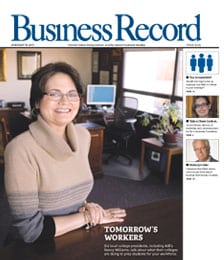‘Comparable to the Great Depression’
Clouds are hanging over the New York Stock Exchange today as news of crumbling financial powerhouses, bank acquisitions and bankruptcies plagues Wall Street. In opening trading, the Dow Jones industrial average plummeted more than 300 points, CNNMoney reported, and Standard & Poor’s 500 index lost more than 1.3 percent.
Art Hogan, chief market strategist for Jefferies & Co., said the magnitude of the financial industry fallout is unprecedented, and could only be compared to the Great Depression of the 1930s or the railroad bankruptcies of the 1800s.
“We’ve never witnessed this before,” Hogan said. “There’s no road map for this.”
In the aftermath of last week’s announcements, Lehman Bros. Holdings Inc. officially announced it was filing for Chapter 11 protection in New York in the early morning hours today. The filing came after the company failed to find a buyer and the Federal Reserve didn’t step in to take control.
Both Bank of America Corp. and Barclays plc withdrew from negotiations to acquire Lehman, and Lehman shares plunged 93 percent.
Jim Sandager, principal of Sandager Advisors LLC, a West Des Moines investment advisory firm, said he believes the Federal Reserve made the right move by not bailing out Lehman Bros., “especially for the long-term functioning of the economy.”
“(The Federal Reserve ) felt they had to draw a line in the sand,” Sandager said, noting that the market has had more time to absorb these losses than was the case with the Fed’s attempted bailout of Bear Stearns Cos. Inc., which received a Federal Reserve emergency loan but could not avert a collapse.
Regardless of how volatile the market becomes, the first question that investors must continue to ask is: “Am I going to be able to continue to meet my long-term financial goals?” Sandager said.
“The way you reduce that volatility is to have a diversified portfolio; that’s the way we’re approaching it,” he said. “We’re paying close attention to this, and making sure our clients are able to meet their goals for the risk tolerance and time horizon they have.”
The Associated Press said that this is the largest failure of an investment bank since the collapse of Drexel Burnham Lambert 18 years ago.
“My goodness. I’ve been in the business 35 years, and these are the most extraordinary events I’ve ever seen,” said Peter Peterson in a New York Times article. He was a co-founder of the private equity firm The Blackstone Group, headed Lehman in the 1970s and served as secretary of commerce in the Nixon administration.
But even though it pulled back from buying Lehman Bros., Bank of America found a different investment, announcing its acquisition of Merrill Lynch & Co. Inc. for $50 billion in stock. Merrill posted net losses of more than $17 billion during the past four quarters, and agreed on Sunday to sell itself to BofA to avoid deepening financial troubles.
However, Wall Street responded to BofA’s acquisition of Merrill with skepticism, reflected in the 16 percent drop in BofA’s share price in early morning trading. Conversely, Merrill shares rose 24 percent in early trading.
BofA’s announcement comes just two months after the company acquired troubled mortgage lender Countrywide Financial Corp. for $4 billion. CEO Ken Lewis said the company plans to handle the Merrill acquisition similarly to the Countrywide takeover, by initially cutting costs. The company expects to recognize $2 billion in cost savings in coming years, and Lewis scoffed in a CNNMoney article at the notion that the company’s projections could be overstated.
“We’re good at this,” Lewis said. “This isn’t the first time we’ve done this.”
Also trying to avoid deepening financial troubles is American International Group Inc. (AIG), which approached the Federal Reserve last night with a request for a $40 billion bridge loan in efforts to avoid financial doom.
Initially, three companies offered to invest in AIG, but withdrew due to anxiety over the company’s precarious health. J.C. Flower & Co. offered to take an $8 billion stake in the business, and Kohlberg Kravis Roberts & Co. and TPG Capital also expressed interest in bidding.
The New York Times cited a close friend to the firm who said if AIG didn’t receive financial help, it may only survive for 48 to 72 hours.
AIG has become one of the largest underwriters of complex debt securities known as credit default swaps, used as insurance for a wide range of products, including the mortgage instruments that have been the bane of Wall Street for the past year, The New York Times reported.
However, AIG’s financial battles have been ongoing; it recorded a $13.2 billion loss in the first six months of 2008.








